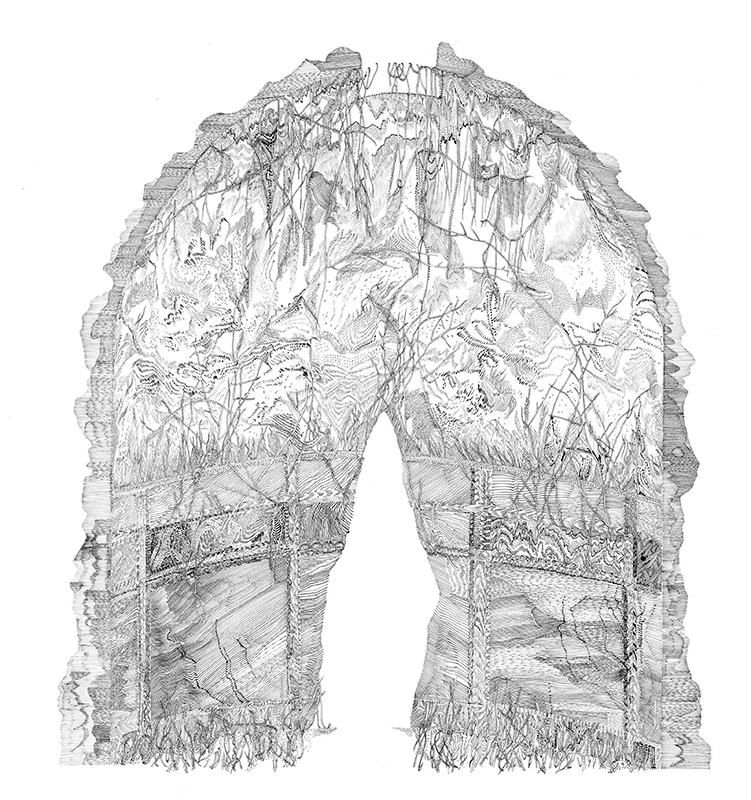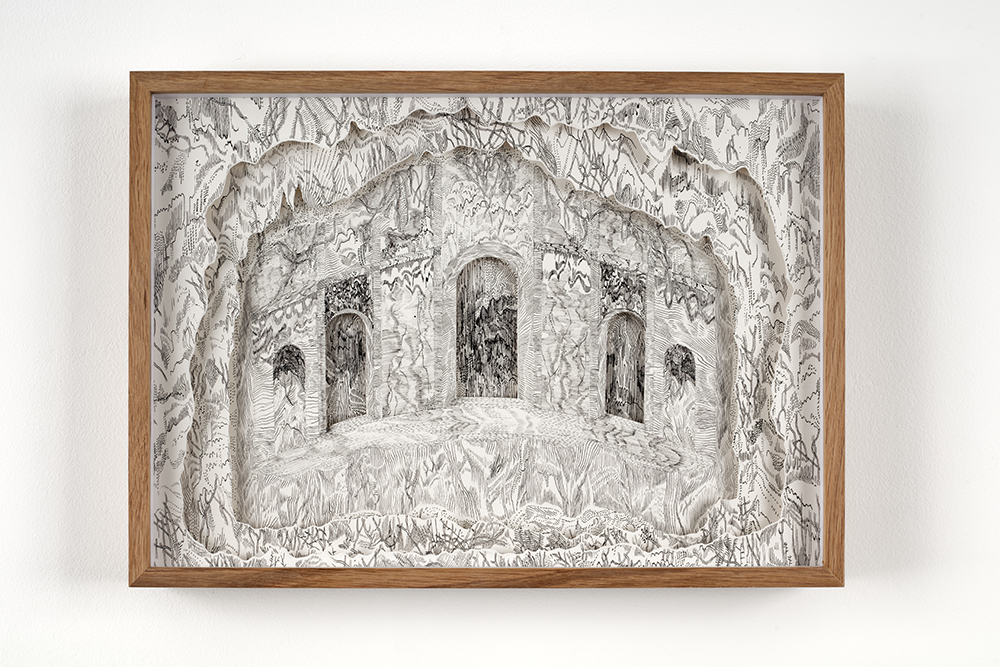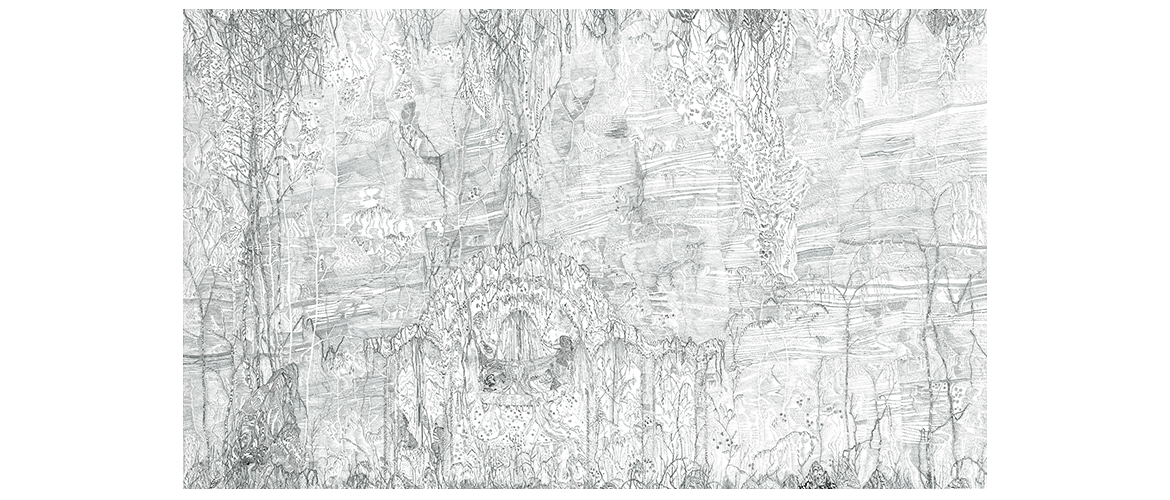Eva Jospin is the new guest in the cycle of the Cabinet des Dessins devoted to artists who have graduated from the Beaux-Arts de Paris and are making their mark on the international art scene.
For the occasion, the artist, known for her sculptures - forests composed mainly of cardboard, caves or follies made of concrete and natural stone - is exhibiting for the first time drawings made with Indian ink. A dozen graphic works that visit the themes dear to the artist, revealing the play of lines and stratifications that structures all his explorations.
It is an exclusive selection of works in Indian ink that Eva Jospin proposes for the cabinet of drawings, rich of nearly 25,000 works. As a familiar figure in sketching, which she uses daily to create her sculptures, the artist identifies two types of drawings in her work. The first is precisely that which she composes for preparatory purposes, a construction plan with explanatory value for her workshop.
The second is an aesthetic research, through a medium that she cherished during her studies, and that she always finds with happiness to express what the other materials or techniques cannot tell.
Unlike the volume that generally characterizes her works, the flat drawing allows a view from above, like a cartography that shows symbolized reliefs. Because her meticulously executed lines evoke the idea of a contour line or even a fingerprint, they also refer to the protruding board that leads to the print. In the background, there is a reference to engraving, a technique she has used in the course of her career, through etching, and which she favored in response to a commission from the Louvre Museum. On this occasion, she entered the collection of chalcographies of national museums, with Grotto in 2017.
To put old works in dialogue with those she has created, her preference was to send in the works of the architects resident at the Académie de France in Rome, Hector-Marie-Désiré d'Espouy (1888) and Jean-Jacques Haffner (1921), dedicated to the Basilica of Constantine: each of them, in their own way, gives a spectacular vision of the building. She then favored a drawing by the painter, archaeologist and diplomat, Louis-François-Sébastien Fauvel, which represents an extraordinary section of the famous grotto of St. John on the island of Antiparos (1789) and four drawings by Louis-François Cassas, who spent several years in Rome to survey the ruined ancient monuments there.
With d'Espouy, Haffner and Cassas, Eva Jospin echoes her love for the architecture of Roman antiquity in particular, appreciating these buildings for their monumental character but also their ruined appearance. Left abandoned and overgrown, they are for her an inexhaustible source of contemplation and reverie. Conceived as exercises, these works take on an invaluable archival and learning value for this graduate of the Beaux-Arts de Paris.
With Fauvel, she shares a fascination for caves. The majestic one represented here is theatrical because of the many celebrations held there, and touching for Eva Jospin because she visited it during a stay in the Cyclades.
Beyond the subjects depicted, the common thread is the spirit of the "Grand Tour", the journey of initiation to beauty and the world that artists had to make in the 17th and 18th centuries, wandering from capitals to cultural centres to contemplate and be inspired by ancient masterpieces.
It is from this tradition that the Prix de Rome was born, a grant awarded to young artists to perfect their skills, such as d'Espouy, who was evaluated in his fourth year by the drawings presented here. Abolished in 1968, the competition was transformed into a pension at the Villa Medici, which Eva Jospin was able to benefit from after her studies at the Beaux-Arts de Paris. It was during her stay that she discovered the embroidery room at the Palais Colonna in the company of a fabric restorer. Here begins a project of great magnitude, that of designing embroidered landscapes. The preliminary sketches necessary for the elaboration of the pieces will influence her style of drawing, because the sense of the line presides over the sense of the embroidery.
His hand, now instructed by all these experiences, composed for the cabinet of drawings of the Beaux-Arts works like poetic reveries, grafted on a familiar structure - whether it is an architectural element (church facade, cenotaph, folly) or a natural element (cave, cliff, mound). An optical walk oscillating between a shared conscious language and an underground world, specific to each viewer.
Curator: Emmanuelle Brugerolles
The Drawing Room
With nearly 25,000 works, the Cabinet des Dessins des Beaux-Arts de Paris has, after the Louvre, the largest collection of drawings in France. The collection is made up of exceptional works by masters such as Leonardo da Vinci, Raphael, Rubens, Poussin and Boucher, and covers a period from the Renaissance to the present day. This wealth of works is closely linked to the history of the School, and is part of its teaching and influence.
Today, the collection continues to be enriched by a policy of acquisitions designed for educational purposes, as well as by donations from professors, young artists, and the association "Le Cabinet des amateurs de dessins des Beaux-Arts de Paris".

Esquisse pour Côté cour Côté jardin, 2021 encre sur papier, 26 x 36 cm © Eva Jospin

Dessin préparatoire pour la Foret de soie, 2021 encre sur papier, 36 x 26 cm © Eva Jospin

Grotto 1, 2019 encre sur papier, 26 x 36 x 4 cm © Eva Jospin




